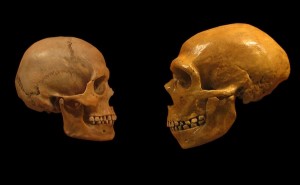Throughout time the cranium size and shape in Neanderthals has drastically changed due to many key factors. Homo neanderthalensis are a primitive analogous race who evolved over many generations into the modern Homo sapiens today. The evolution of cranium size and shape occurs from a multitude of factors, some of which includes the tools they used, certain social aspects of their culture, and many other environmental changes associated with their habitat. All of these evolutionary elements can be integrated into one small region of Neanderthals that holds the most valuable information; the brain. The brain of primitive Neanderthals was slightly elongated and larger than the brains of modern Homo sapiens of today, and even other hominid species of the same time period. Although the brain and cranium size of Neanderthals was larger than other species, there is a reason why the Neanderthal species did not survive to the twentieth century.
With the four fundamental components of evolution, natural selection, genetic drift, gene flow and mutation, the craniums of Neanderthals began to change ever so slightly over generations mainly due to gene flow and the interbreeding between different species. Over 50,000 years ago these primitive hominids interbred with other species through these two aspects of evolution. The Neanderthals lived roughly 20,000-30,000 years ago, and had large heads and facial features (King 1864). These short, big-nosed, big-browed Neanderthals originated in Eastern Europe (LiveScience 2013) and slowly traveled in short distances and to eventually interbreed and diversify their genes with other hominid species of Europe who had significantly smaller craniums. In addition to these interbreeding events, the ancestors of Neanderthals from the Altai Mountains in Asia and early modern humans met and interbred, creating a more diverse gene pool of hominids with slightly smaller craniums (Gunz 2007).
Figure 1: Homo sapien skull compared to a Homo neanderthalensis skull. Available: http://www.smithsonianmag.com/ist/?next=/science-nature/science-shows-why-youre-smarter-than-a-neanderthal-1885827/
The brains of Neanderthals and modern Homo sapiens are shown to be largely different in the development of the cranium. Early stages of brain development in Neanderthals displays that they do not develop through the same processes that Homo sapiens go through and that these developmental processes are not as prevalent and active in Neanderthal species. This difference between cranial development of species results in entirely different functioning brains, which leads to very different sized hominid brains (Bruner 2007). Although nobody truly knows how their brains actually worked differently than Homo sapiens, there is plenty of evidence that suggests this difference in brain functionality.
The difference in brain size of Neanderthals demonstrates that, compared with our ancestors, Neanderthals had less brain space for dealing with certain skills and behaviors. Even though Neanderthals had larger craniums there was less overall brain mass devoted to specific aspects, such as an area of the brain devoted to social cognition (Gunz et al 2010). These Neanderthals had smaller social networks than modern Homo sapiens because of their smaller areas of their brains to deal with social complexity. This can possibly explain why they traveled shorter distances, had fewer tools, and lived in smaller communities. Fossils show that these small communities tended to live in caves and there is evidence that cannibalism occurred within these small communities (LiveScience 2013). Some believe that cannibalism is one of the main reasons that Neanderthals went extinct. Although their heads were much larger than modern humans, these deficiencies in certain skill and behaviour (King 1964) suggest that Neanderthals were not as intelligent as modern homo sapiens.
The study of Neanderthal brains is practiced globally and is key to unlocking more answers to the true origin and evolution of the Neanderthal species. The main evolutionary aspects related to the evolution of cranium sizes are the gene flow and interbreeding between populations of early hominids (Bruner 2007). Due to these factors occurring over thousands of years the large elongated craniums of Neanderthals transformed in size and shape, forming a cranium that more closely resembles the cranial structure of modern Homo sapiens. While Neanderthals are not necessarily modern humans’ ancestors, it is important to note that 99.7% of their DNA is the same as that of modern homo sapiens (LiveScience 2013). Ultimately the brains Neanderthals were determined to be less developed than their competitors, resulting in the inability to survive in changing environmental conditions and to compete for resources, which greatly influenced the extinction of the Homo neanderthalensis race.

